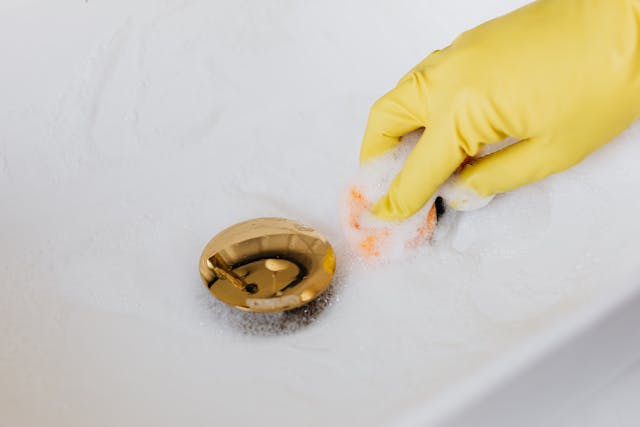Sink drain is an essential component of any sink, whether it’s in the kitchen, bathroom, or laundry room. It ensures that water and waste flow out efficiently, preventing clogs and maintaining hygiene. Understanding how to maintain them can save you time, money, and frustration.
Read about Bathtub Drain Replacement here!
Types of Sink Drains
Sink drains vary based on their purpose and the type of sink they are connected to. Here are some common types:
- Bathroom Sink Drain
The bathroom sink drain is designed for light-duty usage, typically handling water and small amounts of soap residue. It often features a stopper mechanism for holding water in the sink when needed. - Kitchen Sink Drain
The kitchen sink drain is built to handle food scraps, grease, and heavier water flow. It is often paired with a garbage disposal or strainer to prevent large debris from clogging the pipes. - Bar Sink Drain
A bar sink drain is smaller than a kitchen sink drain and is typically used for rinsing glassware or small utensils. It requires efficient drainage since bar sinks are usually in high-use areas. - Mop Sink Drain
Mop sinks are found in commercial or utility spaces. Their drains are designed to handle dirty water, cleaning solutions, and sometimes solid particles.
Components of a Sink Drain
Understanding the basic parts of a sink drain can help with maintenance and repairs:
- Sink Trap: Also known as a P-trap, the sink trap is the curved portion of the drainpipe beneath the sink. It prevents sewer gases from entering the home by holding a small amount of water.
- Drain Stopper: Common in bathroom sinks, the stopper allows you to fill the sink with water when needed.
- Strainer or Basket: Found in kitchen and bar sinks, these components catch debris before it enters the pipes.
Maintaining Your Sink Drain
Proper maintenance is key to keeping your sink drain functioning efficiently. Here are some tips:
- Use Baking Soda and Vinegar Drain Cleaning: A natural and effective method for cleaning drains, baking soda and vinegar help break down grease and remove odors. Pour one cup of baking soda into the drain, followed by one cup of vinegar. Let it sit for 10-15 minutes before rinsing with hot water.
- Clean the Sink Trap: Over time, the sink trap can collect debris and cause clogs. Periodically remove and clean it to ensure smooth drainage.
- Install a Strainer: Using a strainer or basket in your sink drain can catch food scraps and hair, preventing clogs from forming.
Common Sink Drain Problems and Solutions
- Clogged Drains
A clogged drain is the most common issue homeowners face. For minor clogs, a baking soda and vinegar drain cleaning method often works. For more severe clogs, consider using a plunger or calling a plumber. - Slow Drainage
Slow drainage is usually caused by buildup in the pipes. Regular cleaning with natural solutions or a sink drain cleaner can help. - Leaking Sink Trap
Leaks often occur when the sink trap is not properly tightened or has become corroded. Check the connections and replace damaged parts as needed. - Odors from the Drain
Odors can result from buildup in the drain or sink trap. Using baking soda and vinegar can eliminate most smells, while cleaning the sink trap can address persistent odors.
Choosing the Right Sink Drain
Selecting the right sink drain depends on the sink type and its usage:
- For Kitchen Sinks: Opt for a sturdy kitchen sink drain with a built-in strainer or one compatible with a garbage disposal.
- For Bathroom Sinks: Choose a drain with a stopper mechanism for added functionality.
- For Bar Sinks: Look for smaller drains designed to handle frequent water flow without clogging.
- For Mop Sinks: Ensure the drain is robust and resistant to chemicals commonly used in cleaning solutions.
Benefits of Regular Sink Drain Maintenance
Taking care of your sink drains offers several benefits:
- Prevents Clogs: Regular cleaning reduces the risk of clogs, saving you from expensive plumbing repairs.
- Extends Lifespan: Maintaining components like the sink trap and strainer ensures your sink drain lasts longer.
- Eliminates Odors: Proper care keeps your sink drain smelling fresh and hygienic.
- Improves Efficiency: A clean and well-maintained drain allows water to flow freely, avoiding backups.
How to Clean Different Types of Sink Drains
- Kitchen Sink Drain
Clean your kitchen sink drain weekly by flushing it with hot water. For grease buildup, use baking soda and vinegar or a grease-cutting drain cleaner. - Bathroom Sink Drain
Hair and soap residue are common culprits in bathroom sink clogs. Use a small drain snake or a baking soda and vinegar mixture to clear any buildup. - Bar Sink Drain
Bar sink drains often handle less debris, but regular flushing with hot water can help maintain efficiency. - Mop Sink Drain
For mop sinks, clean the drain regularly to remove dirt and chemical residue. Use a heavy-duty cleaner if necessary.
Conclusion
Sink drains play an essential role in maintaining the functionality of your home or business. Understanding how to maintain and clean these drains is crucial. By using simple solutions like baking soda and vinegar or ensuring the sink trap is clear, you can keep your drains running smoothly and avoid costly repairs. With proper care and the right tools, your sink drains will remain efficient and long-lasting.
